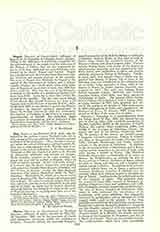

Ibar, Saint, a pre-Patrician Irish saint, who labored in the present County Wexford from 425 to 450, recognized the jurisdiction of St. Patrick, and was confirmed in his episcopacy. Thus, though a missionary before the arrival of the great national apostle, St. Ibar was a contemporary of St. Patrick, and is regarded as the patron of Begerin, in Wexford harbor. Although at first not disposed to yield to St. Patrick he afterwards submitted and became his disciple. Much obscurity attaches to his early training, but about the year 480 he settled at Begerin, where he built an oratory and cell. In the “Life of St. Abban” it is stated that St. Ibar’s retreat was soon peopled with numerous disciples from all parts of Ireland, and the “Litany of Aengus” invokes the three thousand confessors who placed themselves under St. Ibar’s direction. His nephew, St. Abban, as a boy of twelve came to Begerin in St. Ibar’s old age and accompanied him to Rome. His name is variously written Ibar, Iberius, and Ivor, and his death is chronicled in the year 500 on April 23, on which day his feast is observed. Although Begerin was formerly an island in the north of Wexford harbor, it has long since been one of the reclaimed Sloblands.
W. H. GRATTAN-FLOOD

